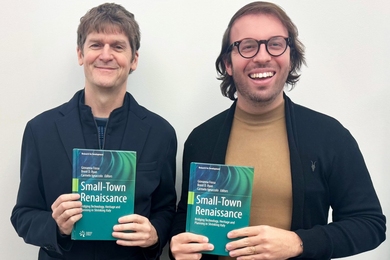CAMBRIDGE, MA--In a break from past thought on the evolution of the
Earth, geologists Samuel Bowring (MIT) and Todd Housh (University of
Texas-Austin) have found evidence that the early Earth quickly developed
a crust and has been over time evolving toward an equilibrium state in
composition and temperature. Predominant theory has the Earth slowly
differentiating into crust and a complementary mantle over its whole
history.
Bowring and Housh's research on 4.0 billion year old rocks
(gneisses) from the Northwest Territories in Canada, described in the
September 15 issue of Science, supports the theory that we have a
limited amount of the very old continental crust because older crust has
been continuously recycled--not because there was little crust early in
Earth history.
Bowring and Housh's work, in studying the Earth's oldest known
rocks, suggest that plate tectonics, the theory that describes the
surface of the Earth as a collage of moving plates, has acted to recycle
existing crust as the edges of plates plunge beneath other plates and
return to the underlying mantle. As the plates, which are the Earth's
crust, return to the mantle, they efficiently recycle the old crust back
to its ultimate place of origin.
"Crust from the Archean period may have been formed in large
volume, but lacking a deep 'root' beneath it, which protected it from
destruction, it may have been mostly recycled back into the mantle,"
said Professor Bowring.
It is only through the study of these old crustal rocks that
geologists can get direct information about the Earth's processes 4
billion years ago. Also, by studying the crust, scientists can learn
about the composition of the mantle of 4.0 billion years ago. These old
rocks from the Archean period (from the time of formation of our planet
to 2.5 billion years ago) were found by Bowring in the 1980s when he was
doing regional mapping to test geological models. It was later, in
studying the rocks' ratios of two elements, Samarium(Sm) and
Neodymium(Nd), that the implications for the Earth's early history
became evident, showing a decrease over the Earth's history in how
differentiated its layers were.
The study of Sm and Nd showed that early Earth was characterized by
regions of very different chemical signatures. The best explaination
for this, Bowring said, is if the Earth formed a crust very early
(generating the diversity) and subsequently continuously recycled that
crust (progressively eliminating the diversity.)
Bowring and Housh also contrast early Earth history to early
evolution of the moon. "The isotopic and geochemical signature of the
Earth's mantle is fundamentally different than that of our nearest
neighbor, the Moon," said Professor Bowring, " because the process of
plate tectonics has operated on Earth over much of its history whereas
on the much smaller and colder Moon it's never operated. Recycling of
both continental and oceanic crust back into the Earth's mantle gives
the Earth a distinctive geochemical signature that is absent in the
Moon."
This research was funded by a grant from the National Science
Foundation.





